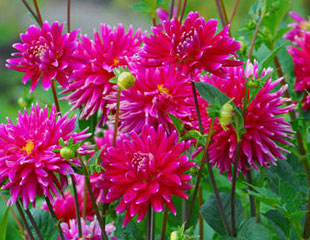


An Easy Way to Overwinter Dahlias
Key points: There are three basic ways to overwinter Dahlia:
The Traditional method, Lift and Store in a frost-free place.
The alternative way: Growing in containers.
Or overwinter in the ground.
Let's take a look at each method of overwintering dahlias together with the pros and cons.
The traditional method of overwintering Dahlia
The traditional method of overwintering dahlias is to dig them up at the end of the growing season. Do this once the frost has arrived and turned the foliage black, and cut off the foliage to around 5 cm. Lift them up with a fork, brush off all the attached soil and hang up the tubers to dry out. When they are 100% dry, pack them in bone-dry compost or vermiculite. Overwinter in a cool, frost-free dry place.
Very often, it is difficult to eliminate all moisture from the tuber, which then tends to get mildew and rot.
We lift the tubers in colder, wetter parts of the country and areas with heavy, clay soils because the tubers will rot in the garden bed over the winter. If you garden in an area which is predominantly drier, like the eastern UK, or if you have light sandy soils without severe frosts, you can safely leave Dahlia in the ground all winter.
Pros
Cons
If your garden soil is wet, or you live in a wet and cold area, Dahlia tubers will not survive winter in the ground.
If the method is followed carefully, many gardeners find it successful.
It can be hard work
Time consuming
If any moisture seeps into the tubers, it will cause them to rot.
Climatic conditions may mean not all tubers survive the winter.
An Alternative Way to Overwinter Dahlias
If your garden is too wet to overwinter in the soil, another way is to grow Dahlias in containers and overwinter them in the containers. Inevitably, it is the case that containers are a drier growing environment, and you can place them in a sheltered spot.
When the first frosts blacken the foliage, cut it back almost to the soil level. Mulch well. You can then decide where to place to container for the winter. In exposed gardens, consider placing in a greenhouse, lean-to, or within the shelter of a wall or shrub to fend off the worst of the winter cold and wet.
Keeping the tubers on the dry side is important. In wet areas, place the container spot sheltered from rainfall.
In early spring, around March time, dig out much of the old compost right down to the tubers, which you can re use the compost. Refill with good-quality peat-free compost and place the container in a nice sunny spot where you would like it to flower. Periodically, you may need to remove some tubers as the plant matures to prevent the container from becoming overcrowded. Dahlias grown this way in containers will always benefit from feeding with a general-purpose or potassium-rich feed such as tomato food.
This is much easier than lifting the tubers and, as shown in the video, excellent growth reappears. This is ideal where conditions are not favourable for leaving the tubers in the ground. If you inspect some of the classic herbaceous borders in large stately gardens, you may see the rim of a container just showing in the soil. The gardener placed the Dahlia in a container for overwintering, then buried the entire pot in the ground at soil level for it to grow and flower over summer. They later remove the entire container in the Autumn.
As an alternative to lifting, grow Dahlias in containers. Illustrated left is a Dahlia grown and overwintered in a container, and it's full of lush new spring growth.
The video shows the Dahlia in full bloom just before autumn frosts. The same Dahlia the following spring having been overwintered and almost ready to flower. The video explains the easier way to overwinter Dahlia which is also set out below.
Pros
Cons
Less effort and easier to do.
If your soil is wet/heavy, it is an ideal way to grow Dahlia.
I found it reliable with Dahlias returning to bloom well the following season.
It is a good compromise where leaving Dahlia in the ground is not an option.
Not everyone wants to grow Dahlia in containers.
It is possible to "plant" the container in the border, but it would require a degree of digging.
Overwinter Dahlias in the soil.
This is only feasible if:
Your garden does not suffer from winter wet
You are gardening in a relatively dry part of the country.
Your garden is not very exposed or cold.
Easy to do. Once the frost has blackened the foliage, cut to around 5cms and mulch well.
Whether or not Dahlias will overwinter in the soil depends entirely on the aspect of your garden. It needs to be dry, not unduly exposed. When I gardened near the Pennines, I struggled to grow Dahlias even in containers. Now in the East, I leave some in the ground and some in containers. All this is complicated by the fact that our winters vary. If you are unsure, why not try one batch of tubers in the ground and the rest in containers, to minimise casualties.
Pros
Cons
Easy and least effort.
Dahlia can be left undisturbed for several years.
Grown consistently in the ground, the tubers may multiply better, resulting in larger, more mature plants.
An element of risk is involved in judging whether ground conditions are suitable.
An unpredictably wet /cold winter could result in some losses.
